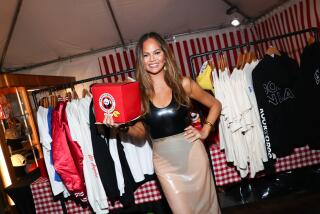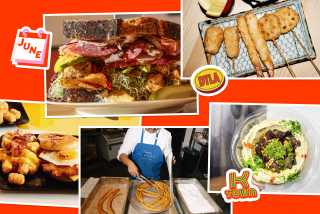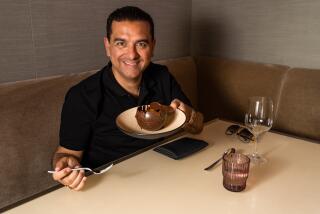Cheesecake Factory Is Cooking
- Share via
Just as the restaurant industry is showing its slowest growth in a decade and rivals are scaling back expansion plans, Cheesecake Factory Inc. has plans to grow more aggressively than ever.
The Calabasas Hills-based chain’s strategy of serving huge portions, offering variety and opening restaurants in affluent neighborhoods will no doubt be tested in the midst of a sluggish economy and declines in eating out.
The chain of 52 Cheesecake Factory outlets and two upscale Grand Lux Cafe restaurants hopes to open 11 namesake outlets and one Grand Lux by year-end. Chief Executive David Overton recently said the company could grow to 200 restaurants in the U.S., up from a previous estimate of 150.
Cheesecake Factory executives said the time is right to expand, because consumers have a big appetite for its offerings. The typical outlet generates annual revenue of $11million, more than four times the average for a casual-dining restaurant, analysts said.
“We’ve basically been able to open our doors and customers would come,” said Jerry Deitchle the company’s chief financial officer.
Cheesecake Factory’s strong sales and profit in both sweet and sour times have made its stock attractive. The company’s shares, up 71% in the last year, hit a record high of $41.35 during trading Monday, although they closed at $40.13, down 2 cents on Nasdaq.
However, some industry watchers think the stock is overpriced, selling at about 40 times estimated 2002 earnings per share.
R. Scott Tilghman, an analyst at Ladenburg Thalmann in New York, said Cheesecake will have difficulty maintaining its historical revenue and earnings growth of 25% or more, partly because it can’t open new stores fast enough. If sales and profit growth sag, Wall Street could hit the stock, which Tilghman rates “market perform” and values at about $30.
Many restaurant companies have scaled back expansion plans or are growing more cautiously in the face of economic uncertainty and rising unemployment, said Tim Carlin of Technomic Inc., a restaurant consulting firm in Chicago.
Outback Steakhouse Inc. plans to open as many as 64 Outbacks in 2002, down from 80 last year, according to regulatory filings. Mark D. Kalinowski, an analyst with Salomon Smith Barney, attributes the slowdown partly to the economy. The Tampa-based company declined to comment.
Similarly, Briazz Inc. plans to christen six restaurants this year, about half as many as originally expected, CEO Victor D. Alhadeff said. The Seattle-based company, which has 43 outlets in four markets including Southern California, has scaled back because sales and profit are down and capital is difficult to obtain on favorable terms.
Restaurants that roll out in tough times risk “falling on their face” should the economy worsen, said Hal Sieling, a Carlsbad restaurant consultant.
Despite the potential roadblocks, analysts said the Cheesecake Factory’s expansion makes sense, given its popularity and track record with new stores.
Because the chain is such a strong draw to a retail location, landlords often reduce rents and pick up part of the tab for the construction of new restaurants, said Lynne Collier, an analyst with Stephens Inc. in Dallas. They are likely to be even more generous in these tough economic times, with the softening commercial real estate market.
With strong cash flow and no debt, Cheesecake Factory has the resources to expand without overextending itself, said Allan Hickok, an analyst at U.S. Bancorp Piper Jaffray.
“They’ve opened more than 50 restaurants and never had a clunker, not even close,” he said. “That’s simply amazing.”
For new locations, Cheesecake Factory targets affluent areas with 200,000 people within a five-mile radius. About three-fifths of its stores are in malls. The cost of putting up a new outlet is $4.5million to $5 million; landlords typically pay 30% to 40% of that, the company said.
The 24-year-old chain’s success also reflects a boom in the casual-dining sector, where the average check ranges from $8 to $20, said Collier, the Stephens analyst.
Casual-dining stocks, which include such strong performers as P.F. Chang’s China Bistro Inc. and Darden Restaurants Inc., the operator of Red Lobster and Olive Garden, have jumped by 50% in the last six months, compared with a 5% increase by the Standard & Poor’s 500, Collier said.
Several factors are driving the growth of casual-dining restaurants. The population of middle-aged people, the sector’s core clientele, is growing at a faster rate than that of young people. And after years of burgers and fries, many Americans are suffering from “fast-food fatigue,” said Harry Milling, an analyst with Morningstar Inc.
Americans like their meals big, and that’s exactly how Cheesecake Factory serves them. Its Famous Factory Meatloaf, which weighs 15 ounces and comes with three-quarters of a pound of mashed potatoes, and its 12-ounce Classic Burger, served with fries, help it stand out in a crowded restaurant market.
With more than 250 items featured on its 18-page menu, including 38 types of cheesecake, the restaurant offers “something for everyone,” said Howard Gordon, senior vice president of business development and marketing for the company.
Cheesecake Factory, unlike almost all its competitors, does no advertising, relying instead on word-of-mouth, the company said.
Judging by the long waits for seats at lunch and dinner, it appears to have struck a chord with consumers, analysts said.
Stanley Apollo, a Westminster resident who visits a Cheesecake Factory about once every couple of weeks, said he eats early, at 5 p.m., to avoid the dinner rush.
“I plan on going there forever,” said Apollo, 71. “There isn’t anything I don’t like about the place.”
*
More to Read
Inside the business of entertainment
The Wide Shot brings you news, analysis and insights on everything from streaming wars to production — and what it all means for the future.
You may occasionally receive promotional content from the Los Angeles Times.










